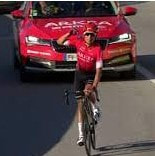
At the start of the final stage, Tim Wellens held a tie-breaker advantage over Nairo Quintana with both having the same time for the first two days of racing. With 40km remaining there was a breakaway group with a 40 second advantage over Wellens, Quintana, and what remained of the peloton. It was at this point that the dynamics of the race were about to change.
With approximately 37km remaining, the breakaway itself had broken up. Three riders were at the head of the race. Two of these three riders were from the same team (Thibaut Pinot and Michael Storer). While out of contention for the overall win, they could garner a stage win. At around the same time, Guillaume Martin decided to attack from the peloton. Fifth in General Classification, Martin posed a threat to riders like Wellens and Quintana. The commentators speculated that Martin would join the three out front and all four would work together. Hypothesis number one.
With 35.2km remaining, possibly spooked by Martin’s move, Quintana decided to attack. With a teammate, he broke from what was left of the peloton. The commentators commended Tim Wellens for not responding immediately to the explosive attack by the lighter rider on the steep slopes. However, it was only a matter of seconds before he was forced to respond.
Out front, Pinot attacked. Hypothesis one now invalid – at least in its original form.
Vuillermoz was second and Storer was third. The speculation was that Storer remained third on Vuillermoz’s wheel as would be normal in these two-on-one situations. Why would he help an opponent catch a teammate? Let us call this hypothesis number two, namely, that Storer’s behaviour was part of a strategy rather than an inability to go with his teammate.
This speculation continued as Quintana and Martin joined Vuillermoz and Storer to form a group of four behind Pinot. Storer’s strategy to free-ride on the effort of the other three continued to make strategic sense. He was not going to help the others make up the 10 second on Pinot. The commentators noted that Quintana and Martin accepted this (rational) behaviour as part of cycling’s informal rules.
When Quintana left Storer, Martin and Vuillermoz in his wake, it was Storer who tried to respond. This was consistent with hypothesis two. He would try to catch Quintana and then sit on Quintana wheel as Quintana chased Pinot. However, Storer could not catch Quintana.
With 29.6km Quintana caught Pinot. The Columbian and the Frenchman rode together for a number of kilometers. At 25.5km the commentators speculated that Quintana might gift Pinot the stage if Pinot shared the workload. Pinot would win the stage and Quintana the overall race. Hypothesis number three. At this point, Wellens was 25 second behind.
With 20.5km Wellens caught the three behind Quintana and Pinot. The commentators predicted that Wellens would catch Quintana before the finish. Hypothesis number four. At this point, probably prompted by the change behind, and after 10km riding together, Quintana left Pinot to strike for home. With that move hypothesis number three bit the dust.
Now the commentators started to speculate why Martin and Vuillermoz should help Wellens in his attempt to catch Quintana. With just over 16km to go the group picked up Pinot. The commentators predicted that the five riders would not just leave Quintana win the stage. Moreover, they noted the fact that Storer had been free-riding and, therefore, might be in the strongest position. The implicit hypothesis number five was that the five riders were in the physical condition to chase down Quintana. Storer had earlier failed to lead Martin and Vuillermoz back to Quintana. Now the group included Wellens and Pinot. Five is better than three. But only if all are able to contribute.
However, Quintana was starting to increase his advantage as Wellens was left to lead the chasing group. The commentators found it “quite puzzling” as to why the others were not helping Wellens even though they acknowledged that there was a tradition of not helping the overall race leader catch the person in second place in General Classification. At 12.3km the commentators said that the decision not to help Wellens must be part of a plan. Hypothesis number six.
All the while Quintana stretched his lead. It was 60 seconds with 11.5km remaining when Martin attacked and opened a gap on Wellens and the others. This changed the mind of the commentators. The lack of reaction of the other to the Martin-attack made them state that the others did not have the physical capacity to react rather than it being part of a plan. Hypothesis five bit the dust. Hypothesis six bit the dust. And hypothesis four, that Wellens would catch Quintana before the finish, was about to bite the dust.
With just under 10km to go, the commentators declared that the efforts to catch Quintana were “mission impossible”. From here to the finish Quintana’s efforts were described as a “force of nature”. Only hypothesis two, of the six outlined, was left standing as the storm of the previous 30km settled.
As the facts changed, the commentators changed their mind. I like this approach. When it became apparent that the riders could not match Quintana, the commentators accepted what they saw and changed their minds. It was no longer the plan that was the problem. Too frequently, I listen as other commentators and analysts criticize competitors for not making their hypothesis hold water. The more confidently the prediction were made, the more strident the criticism of the competitors. This was not that case on Eurosport last Sunday. The commentary highlighted the dazzling dynamics of professional road cycling where informal coalitions are formed and dissolved as the circumstances change. Keynes would approve.
 RSS Feed
RSS Feed